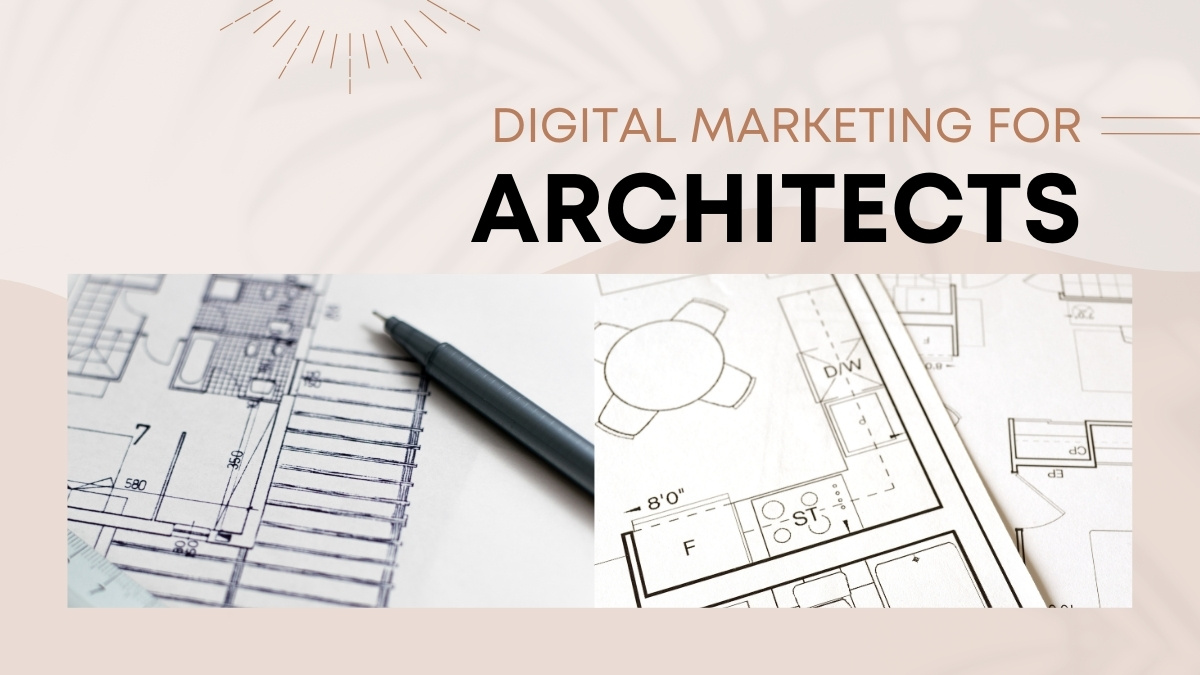
Digital Marketing for Architects
You design incredible spaces that shape how people live, work, and connect. But how do you connect with the clients who need your vision? In a world where potential clients search for everything online, from the best local coffee shop to their dream home designer, simply being a great architect isn't enough. Your firm needs to be visible where your clients are looking.
This is where digital marketing comes in. It’s not about flashy ads or complicated tech jargon. It’s about creating a smart, sustainable way to showcase your work, connect with the right people, and grow your practice. This guide will walk you through everything you need to know, step by step. We'll cover the essential strategies, the benefits, and the practical first steps you can take to build a powerful online presence. Along the way, you’ll find handy examples and tips tailored to architects, whether you’re just starting out or want to upgrade your firm’s digital presence.
What is Digital Marketing, Anyway?

Let's break it down. Digital marketing is simply using online tools and platforms to promote your services. Think of it as the modern-day equivalent of a glossy magazine feature, a client referral, and a business card, all rolled into one powerful package.
For an architect, it’s not about selling a product off a shelf. It’s about building a reputation and telling a story. Your work is visual, detailed, and deeply personal. Digital marketing provides the perfect canvas to display your projects, share your design philosophy, and attract clients who value your unique approach. It’s how you turn your portfolio into a lead-generating machine.
Digital marketing includes everything you do online to get noticed by the right audience, from posting your latest project on social media, to writing a blog about eco-friendly building techniques, to sending out a monthly newsletter. It can seem overwhelming, but the trick is to break it into manageable steps and focus on what works for you and your business goals.
Key Digital Marketing Strategies for Architects

Getting started doesn't have to be overwhelming. Focus on a few core strategies that deliver the biggest impact. Here’s your blueprint.
Build a Professional Website
Your website is the foundation of your digital presence. It's your firm's online headquarters, your digital portfolio, and the first impression for most potential clients. It needs to do more than just look good; it needs to work for you.
-
Showcase Your Portfolio: Use high-quality, professional photos and videos. For each project, tell a story. What was the client's problem? What was your solution? Let visitors see the transformation. If you specialize in sustainable homes, highlight before-and-after shots or time-lapse videos of eco-friendly installations. Don’t just post pictures—share the story behind each build.
-
Make it User-Friendly: People will visit your site on phones, tablets, and desktops. Your website must look and function perfectly on all of them. This is called responsive design, and it's non-negotiable. A portfolio slideshow that works beautifully on a laptop but not on a phone could cost you a client.
-
Clearly State Who You Are: What is your specialty? Residential, commercial, sustainable design? Make it obvious on your homepage. Add a tagline or a banner stating, “Modern Home Specialists in Austin, TX” or “Award-Winning Commercial Architects.”
-
Easy to Contact: Your phone number, email address, and a simple contact form should be easy to find on every page. Don't make potential clients hunt for it. Include a “Request a Consultation” button in your main menu or as a sticky footer.
Bonus Tip: Add testimonials and client reviews throughout your website. Word of mouth is still powerful, even online. Short video testimonials or quotes with client portraits can boost trust instantly.
Search Engine Optimization (SEO) for Architects
What good is a beautiful website if no one can find it? Search Engine Optimization (SEO) is the process of helping your website show up on search engines like Google when people search for terms related to your services.
Think about what your ideal client would type into Google. It’s probably not just "architect." It’s more likely "residential architect in [Your City]," "modern kitchen design ideas," or "sustainable home builder."
Your goal is to sprinkle these keywords naturally throughout your website—in your page titles, headings, project descriptions, and blog posts. This tells Google that your site is a relevant result for those searches, helping you attract local and interested clients.
-
Make sure your Google Business Profile is up to date. List your business in local directories, and include your firm’s address on your website footer.
-
Write articles about local architecture news, “Top 10 Tips for Planning a Home Addition in [Your City],” or “How to Survive a Commercial Renovation.” These topics help you appear in more specific searches.
-
Use descriptive file names and alt-text for your project photos. For example: “modern-loft-renovation-downtown-chicago.jpg.”
-
Help visitors and search engines by linking between pages and blog posts on your site. For example, if you reference a home extension project in a blog post, link directly to its portfolio page.
Quick Wins: Register your site with Google Search Console. It’s a free tool that shows how your site performs in search and flags any errors.
Social Media Marketing
Social media is not just for influencers and big brands. For architects, it's a powerful visual storytelling tool. You don't need to be on every platform. Choose the ones where your clients are most likely to be.
-
Instagram & Pinterest: These are your best friends. They are visual platforms perfect for showcasing stunning project photos, design details, and behind-the-scenes glimpses of your process. Use them to create a visual mood board that represents your firm's style. A weekly “Work in Progress Wednesday” post can help followers connect with your creative process.
-
LinkedIn: This is your professional network. Use it to connect with other industry professionals, developers, real estate agents, and potential commercial clients. Share articles about industry trends, company news, and project milestones. Sharing thought leadership, such as your insights on sustainable urban planning, can position you as an industry authority.
-
Facebook: Good for local firms that want to reach homeowners in the community. Join local groups, share event invites (like open house tours), and use Facebook’s events or marketplace features.
Actionable Tip: Batch-create your social content ahead of time, and use a simple scheduling tool like Buffer or Later. This keeps you consistent, even during busy periods.
Content Marketing
Content marketing is about creating and sharing valuable information to attract and engage your target audience. It positions you as an expert and builds trust. It's not a direct sales pitch; it's a way to prove your value.
-
Write articles that answer your clients' common questions. Examples: "How to Choose the Right Architect for Your Project," "5 Things to Consider Before a Home Renovation," or "The Rise of Biophilic Design in Urban Spaces."
-
Go deeper than your portfolio. Create detailed case studies for your best projects. Outline the challenge, your process, and the final outcome, complete with testimonials and stunning imagery. Demonstrate your expertise in solving unique problems, like converting historic properties into modern living spaces.
-
A video tour of a completed project can be incredibly compelling. Short videos explaining a design concept or showing the construction process can also engage your audience on social media. Even a simple “day in the life” clip at your job site can humanize your brand and attract followers’ interest.
-
Create downloadable guides such as “What to Ask Before Hiring an Architect” or “Building Permit Checklist for Homeowners.” These build your email list and position you as a helpful resource.
Pro Tip: Repurpose your content! A single project can fuel a blog post, an Instagram story, a YouTube tour, and a downloadable checklist. Working smarter, not harder, keeps your marketing manageable.
Email Marketing
Email marketing is one of the most effective ways to nurture relationships with potential clients. When someone signs up for your email list (perhaps to download a helpful guide from your website), you have a direct line of communication with them.
Use email to:
-
Share your latest blog posts or projects. A monthly recap of your best work keeps your audience inspired and informed.
-
Send out a monthly newsletter with firm updates. Include staff spotlights, awards, or upcoming events.
-
Offer exclusive design tips. Share something helpful and unique, such as “Three Space-Saving Tricks for Small Apartments.”
-
Keep your firm top-of-mind so that when they are ready to start a project, you're the first person they call.
Ideas to Grow Your List: Offer a free planning worksheet or project checklist in exchange for email sign-ups. Pop-ups or banners can help, but always focus on providing real value.
Automation for Beginners: Most email services (Mailchimp, ConvertKit) let you set up automated welcome emails. Sending a friendly hello and a helpful resource automatically makes a great first impression.
Online Advertising
While the strategies above focus on attracting clients organically, online advertising can give you an immediate boost.
-
Google Ads: You can run ads that appear at the top of Google search results for specific keywords, like "commercial architects in [Your City]." You only pay when someone clicks on your ad, making it a targeted way to reach people actively looking for your services. Start small with your local area and use measurable goals, like form submissions or phone calls.
-
Social Media Ads: You can run highly targeted ads on platforms like Instagram and Facebook. For example, you could show an ad for your high-end residential services to users in specific wealthy zip codes who have shown an interest in real estate and luxury goods. Facebook allows you to target by interests, age, location, and even recent life events (like moving or getting married).
Smart Tips: Try promoting a featured project post or offering a free “design consultation” to generate leads. Always set a clear budget and track your results. With digital ads, a little goes a long way if you’re strategic.
Benefits of Digital Marketing for Architects

Investing time and effort into digital marketing pays off significantly. Here are the key benefits:
-
Digital marketing helps you reach clients who are specifically looking for your style and expertise. Instead of fielding random inquiries, you get approached by people who resonate with your work.
-
Your portfolio is no longer limited to local magazines. The internet gives you a global stage—and connects you with clients, collaborators, and even journalists worldwide.
-
Consistently sharing your work and philosophy builds a reputation and a brand that clients trust and recognize. Over time, your online presence can set the tone for referrals—clients may find you online, but hire you because of your reputation.
-
Many firms are still slow to adopt digital marketing. A strong online presence can set you far ahead of the competition. For example, being active in local Facebook groups or publishing unique case studies may help you win projects over more established but less visible competitors.
-
Digital marketing creates opportunities for ongoing relationships. Past clients may come back with new projects, refer their friends, or leave glowing reviews that boost your credibility even more.
Architect Insight: A well-maintained online presence often attracts media opportunities, partnerships, and invitations to speak at local or national events—opening doors for your practice you might never expect.
Common Mistakes to Avoid

As you get started, be aware of these common pitfalls:
-
The majority of website traffic now comes from mobile devices. If your site is difficult to use on a phone, you will lose potential clients. Always test your site on multiple devices before launching.
-
Your website, social media profiles, and marketing materials should all have a consistent look and feel. This includes your logo, color scheme, and messaging. Create a simple brand guide for reference and use the same profile photo or logo everywhere.
-
Tools like Google Analytics are free and show you how people find and use your website. Ignoring this data is like designing a building without looking at the site survey. Track which pages or posts get the most attention, and focus your efforts there.
-
Digital marketing is a marathon. It takes time to see results from SEO and content marketing. Be patient and consistent. Avoid jumping from strategy to strategy without giving each one time to succeed.
-
It’s tempting to sign up for every platform and tactic. But spreading yourself too thin can backfire. Pick one or two channels and build them out before adding more.
Helpful Reminder: Set realistic goals and timelines. For example, aim to publish one blog post per month and update your portfolio every quarter. Celebrate small wins!
Practical Tips to Get Started
Feeling ready to dive in? Here are a few simple, actionable steps you can take right now.
-
Secure Your Domain: If you haven't already, purchase a domain name for your website (e.g., www.YourFirmName.com). Choose something short, clear, and easy to spell.
-
Set Up Your Website: Use a user-friendly platform like Squarespace or Wix, which have beautiful templates perfect for portfolios. You can always hire a professional developer later as you grow. Don’t forget an “About” page to introduce yourself and your team.
-
Create One Great Case Study: Pick your favorite project. Write a detailed description of the process and results. Get a client testimonial and upload the best professional photos you have. Case studies are powerful references and can lead to word-of-mouth referrals.
-
Start a Content Calendar: Plan out one blog post or social media post per week. Keep it simple. The goal is consistency, not volume. You might spotlight completed projects, share before-and-after images, offer design tips, or discuss common building challenges.
-
Claim Your Social Profiles: Even if you don't plan to be active immediately, create profiles on Instagram, Pinterest, and LinkedIn with your firm's name to secure them. Fill out your profile details fully—include your website link, specialties, and a contact option.
More Steps to Accelerate Success:
-
Participate in local Facebook groups, Houzz, or specialized forums. Answering questions or sharing advice can raise your profile.
-
Reach out to happy clients and ask for reviews on Google, Houzz, or Facebook. Reviews can make a huge difference in attracting new leads.
-
Collaborate with interior designers, landscapers, or contractors for cross-promotion online.
Tech Tip: Set up Google Alerts for your firm’s name and industry keywords. This keeps you in the know and helps manage your online reputation.
Conclusion
Digital marketing is no longer optional for architects who want to thrive. It is the most powerful tool you have to control your narrative, showcase your unique talent, and connect with the clients who will help your firm grow.
You don't need to become a marketing expert overnight. Start with one thing. Build a simple website. Post one project on Instagram. Write one blog post. By taking that first small step, you are laying the foundation for a stronger, more visible, and more successful practice.
Remember: Every step you take online leaves a digital footprint. Stay authentic to your brand, make use of the advice here, and soon you’ll see the impact—more inquiries, better projects, and lasting professional connections. Your designs deserve a wider audience. Digital marketing is your blueprint to reach them.
30 minutes
Expert Consultation
Terms & Agreements
By booking a free 30-minute consultation, you agree to our terms, including scheduling, cancellation policies, and confidentiality. The session provides expert advice without guarantees of specific outcomes or results.






Leave a Reply
Your email address will not be published. Required fields are marked *